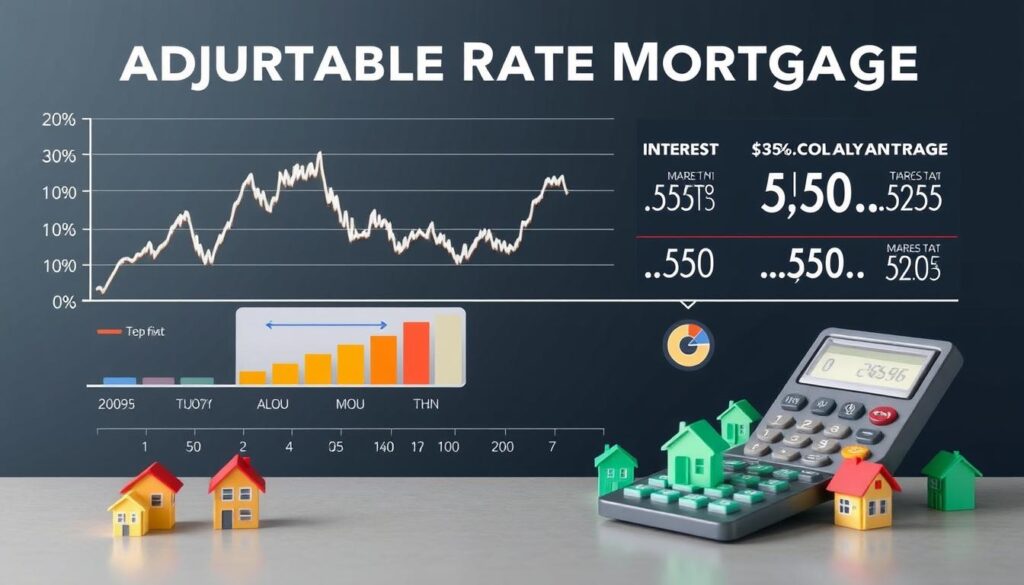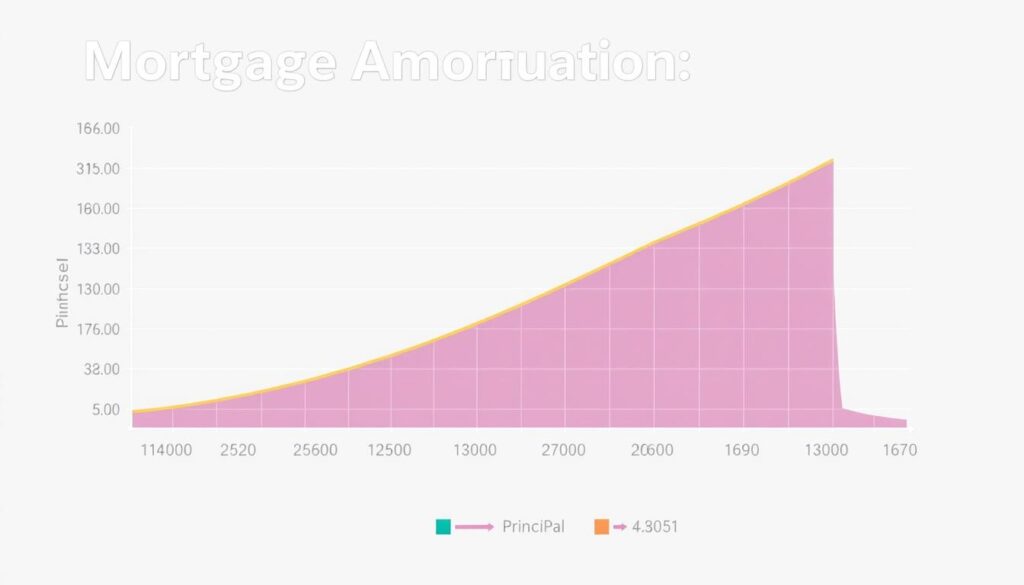When we delve into the world of homeownership, a foundational concept is the practice of amortizing home loans, a term that often enters discussions about financial planning and property investment. Essentially, by understanding loan amortization, we can dissect the method of repaying a mortgage in systematic monthly installments over an agreed period. A traditional 30-year fixed-rate mortgage, for instance, translates to 360 monthly payments calculated to whittle down the borrowed sum.
The mechanics of mortgage payments explained begin with the division of these payments toward two distinct portions: interest and principal. Typically, in the early stages of loan repayment, we notice a higher amount of our monthly payment being consumed by interest. To illustrate, the initial monthly splinter for a home loan worth $200,000 with a fixed 5% interest rate might look like $833.33 going towards interest, while only $240.31 reduces the principal. As we progress through the term, this ratio gradually tilts, favoring the principal deduction, thereby mitigating the overall interest paid across the loan’s life.
Take heart in knowing that the flexibility to manage these payments strategically presents an opportunity for us to save significantly. Adding a relatively modest extra sum, such as $100, to the principal payment each month could yield a profound impact—saving $37,069 in interest on a 30-year mortgage at a 5% interest rate. Thus, gaining a firm grasp on the principle of amortization is instrumental for us to navigate our mortgage payments efficiently and make astute financial choices.
Key Takeaways
- Mortgage amortization details the process of gradual debt reduction through regular payments over a set term.
- Breaking down mortgage payments reveals early installments as predominantly interest-heavy, shifting over time to favor the principal.
- Additional payments toward the principal can produce significant interest savings across the span of the loan.
- Monthly interest is calculated by taking the annual rate, dividing by 12, and then applying it to the remaining loan balance.
- An amortization schedule is a vital tool, demonstrating the allocation of each payment toward interest and principal.
What Is Mortgage Amortization?
At its core, mortgage amortization terms represent the structured approach to paying down a home loan over time. This process entails making regular payments, which cover both the principal amount and the interest accrued. The goal is to decrease the amount owed and eventually own the property outright.
The Basics of Paying Off Your Home Loan
Mortgage payments typically include not just the loan amount and interest, but also homeowners insurance and property taxes. Each payment you make on a mortgage goes towards both reducing the principal and covering the interest, which is calculated based on the outstanding balance. As time progresses, the interest portion decreases while the principal portion increases, a process known as amortization.
Fixed-Rate vs Adjustable-Rate Mortgage Amortization
Choosing between a fixed-rate mortgage and an adjustable-rate mortgage (ARM) can significantly affect your repayment strategy and financial planning. A fixed-rate mortgage keeps the interest rate and monthly payments consistent throughout the loan term, facilitating straightforward budget management and predictability. Conversely, with an adjustable-rate mortgage, the interest rate can change periodically based on prevailing economic index rates, which can lead to fluctuations in monthly payment amounts.
The differences in mortgage amortization schedules between these two types of mortgages are evident in their payment structures. For instance, with a fixed-rate mortgage, borrowers benefit from the stability in interest rates and amortization schedules. Payments are split into equal installments, where the interest proportion diminishes over time allowing increased payments towards the principal.
Conversely, an ARM might start with lower initial payments, but as rates adjust, there can be significant variability in payment amounts, affecting how quickly the loan balance decreases. Borrowers may face higher payments as rates increase, which can impact their long-term financial planning.
To illustrate, consider a $400,000 30-year mortgage with a 7% interest rate and monthly payments. By making biweekly payments instead of a monthly schedule, a borrower can significantly reduce the interest payable over the life of the loan, illustrating one of the strategic options available to homeowners looking to amortize their loans more effectively.
Ultimately, understanding the complexities of mortgage amortization terms and how they apply to both fixed-rate mortgages and adjustable-rate mortgages can empower homeowners to make informed decisions that align with their financial goals and circumstances.
Mortgage Amortization Terms Explained
Understanding mortgage amortization terms is crucial for any homebuyer or homeowner. It impacts not only the schedule of payments but also long-term financial planning regarding home loans. Let’s delve into how the amortization period and interest rates configure the trajectory of your loan repayment.
Understanding the Amortization Period
The duration chosen to spread out the loan payments essentially determines the amortization period. Commonly, periods spread across 15 to 30 years depending on the borrower’s financial preference and capabilities. Shorter periods such as 15 years favor quicker equity building and less total interest cost, but come with higher monthly payments. For instance, on a $200,000 mortgage at 4.5%, opting for a 15-year amortization results in monthly payments of $1,529.99 and a total interest cost of $75,397.58.
In contrast, a 30-year amortization period, while featuring a more manageable monthly payment of $1,013.37, accumulates a significantly higher interest amount of $164,813.42 over time.
Role of Interest Rates in Amortization
The applied interest rate dramatically affects the mortgage amortization schedule. Initially, a major portion of the payment is allocated towards the interest rather than the principal. This scenario shifts gradually over the period, ultimately resulting in higher contributions towards the principal as the balance decreases. Adjustable-rate mortgages may seem tempting because of potentially lower initial payments; however, they carry the risk of increasing payments over time.
Additionally, homeowners who opt for making extra payments toward their mortgage can significantly cut down the total interest cost and shorten their loan’s amortization period. For instance, adding extra payments to a 30-year loan might reduce the amortization period to about 23 years, realizing a savings of approximately $43,204.16 in interest.
| Mortgage Type | Duration | Monthly Payment | Total Interest | Total Cost of the Loan |
|---|---|---|---|---|
| 30-Year Fixed-Rate | 30 years | $1,013.37 | $164,813.42 | $364,813.20 |
| 15-Year Fixed-Rate | 15 years | $1,529.99 | $75,397.58 | $275,398.20 |
Understanding these mortgage amortization terms and their implications on your financial health allows you to better strategize loan payments, ultimately securing economic stability and possibly saving a significant amount of money over the duration of the loan.
The Amortization Schedule Demystified
To fully grasp the mechanics behind your monthly mortgage payments, it is crucial to develop a solid understanding amortization schedule. An amortization schedule is a comprehensive table, illustrating how each payment impacts the loan balance and equity over the duration of the mortgage.
Initially, the larger share of your payment is applied towards the interest, with a smaller portion reducing the principal. However, as the balance decreases, the proportion of the payment contributing to the principal increases. This dynamic is pivotal in understanding how long it will take to pay off the loan and how much interest you will pay in total.

Considering the long-term nature of most mortgages, knowing how to read this schedule allows homeowners to plan financial strategies like refinancing or making extra payments. Below is an example of an amortization schedule for the first year of a 30-year fixed-rate mortgage with a starting balance of $480,000 after a 20% down payment, at an interest rate of 6.75%.
| Payment No. | Principal | Interest | Total Payment | Remaining Balance |
|---|---|---|---|---|
| 1 | $413.27 | $2,700.00 | $3,113.27 | $479,586.73 |
| 2 | $414.08 | $2,699.19 | $3,113.27 | $479,172.65 |
| 3 | $414.89 | $2,698.38 | $3,113.27 | $478,757.76 |
As demonstrated, each subsequent payment slightly increases the amount allocated towards the principal while the interest expense decreases. This pattern continues, ultimately leading to building more equity and reducing the debt more significantly towards the end of the amortization schedule.
Understanding the details of the amortization schedule not only clarifies how monthly mortgage payments are structured but also highlights the benefits of extra payments toward principal. This can significantly decrease the total interest paid and shorten the term of the loan, leading to earlier financial freedom and potential savings.
We encourage homeowners to review their amortization schedule annually or upon significant financial changes to make informed decisions about their mortgage and overall financial strategy.
Calculating Your Monthly Mortgage Payments
The journey to understanding your monthly mortgage payments begins with recognizing the diverse components that make up the total cost. Each element—from the principal to the interest, and from property taxes to homeowners insurance—plays a critical role in shaping the final amount you will need to budget for.
Factors That Affect Your Payment Amount
To demystify how your monthly payments are calculated, it’s essential to understand the major components that affect it:
- Principal: This is the loan amount borrowed from your lender and repaid over the loan’s duration.
- Interest: Lenders charge an interest rate on the loan amount, which is divided by 12 to determine the monthly interest rate. This interest is compounded over time.
- Property Taxes: Assessed annually by local authorities, these are often included in monthly payments and held in an escrow account.
- Homeowners Insurance: This insurance covers potential damages to your home and is a mandatory component of mortgage payments.
- Private Mortgage Insurance (PMI): Required for loans where the down payment is less than 20%, this insurance protects the lender in case of default.
Using Online Amortization Calculators
For those keen on managing their finances effectively, online amortization calculators can be invaluable. These tools allow you to input variables such as home price, down payment, loan term, and interest rate, giving a clear picture of what the monthly payments will be. Besides just calculating payments, these calculators can show how additional payments can affect your loan’s amortization schedule, potentially saving you money on interest and shortening the loan term.
To illustrate, here’s how you can use mortgage payments explained effectively through an amortization calculator:
| Input | Details | Effect on Mortgage |
|---|---|---|
| Home Price | $200,000 | Base amount for loan calculation |
| Down Payment | 20% | Reduces principal, avoiding PMI |
| Interest Rate | 5% annually | Determines the interest component of the monthly payment |
| Loan Term | 30 years | Affects the total number of payments and overall interest paid |
By integrating these factors into an online amortization calculator, homeowners can gain clear insights into their financial commitments and explore how making extra payments can advance their mortgage payoff timeline, thus proving an indispensable tool for long-term financial planning.
How to Read and Interpret Amortization Tables
When managing a mortgage, it’s essential that we understand the amortization schedule. This tool provides a clear, month-by-month breakdown of how each payment affects your loan balance over time, engaging you deeply into the economics of your home purchase. By parsing through an amortization table, we see not just the journey of repayment but also strategic points where we can intervene to save on interest and shorten our loan term.
The typical amortization schedule includes several critical columns such as Period, Beginning Loan Balance, Payment, Interest, Principal, and Ending Loan Balance. Let’s decipher them:
| Period | Beginning Loan Balance | Payment | Interest | Principal | Ending Loan Balance |
|---|---|---|---|---|---|
| 1 | $300,000 | $1,716 | $875 | $841 | $299,159 |
| 2 | $299,159 | $1,716 | $873 | $843 | $298,316 |
| … | … | … | … | … | … |
| 180 | $5,473 | $1,716 | $16 | $1,700 | $3,773 |
An insightful glance at this table reveals how, primarily in the initial stages of your mortgage, a significant portion of your payment is allocated towards the interest rather than the principal. This common trait in mortgage amortization terms highlights the benefit of potentially making additional principal payments early in the term. Accelerating your principal payments can drastically reduce the amount of interest paid over the life of the loan, as illustrated by the quick decrease in the principal balance with each subsequent payment in an amortization schedule.
Also, it’s worth noting how staggered extra payments can impact your amortization. For instance, an extra payment early in the schedule could save you more in interest than the same amount paid years later. Each row in this table serves as a strategic indicator for when extra payments could be most beneficial, helping us to navigate our fiscal path more effectively.
Understanding these tables allows us to make informed decisions about our finances. Whether considering refinancing or adjusting your payment plan, the amortization schedule provides a framework through which we can visualize and strategize the fulfillment of our mortgage obligations efficiently.
Strategies for Amortizing Home Loans Effectively
When it comes to amortizing home loans, implementing strategic payments can significantly enhance your financial autonomy and reduce long-term interest burdens. Understanding and applying methods like making extra payments or opting for accelerated mortgage payments can lead you towards rapid mortgage freedom.
The Impact of Extra Payments on Amortization
Extra payments towards your home loan can dramatically alter the course of your loan’s amortization schedule. By contributing additional amounts towards the principal, you reduce the balance more swiftly, thereby decreasing the interest accumulated over time. For instance, on a $200,000 30-year loan at 4% interest, an extra $100 per month on top of the regular payment can shorten the loan term by over 4.5 years and save you over $26,500 in interest.
Benefits of Accelerated Mortgage Payments
Accelerated mortgage payments involve making more frequent payments and can significantly decrease the interest paid over the life of the loan while also hastening the payoff period. By switching to a bi-weekly payment plan, where half the monthly payment is made every two weeks, you effectively make one additional monthly payment each year. This adjustment can reduce the term of a 30-year mortgage by over four years and save more than $22,000 in interest, illustrating the profound impact of accelerating your mortgage payments.
To maximize the benefits of these strategies, it’s crucial to consult with your lender to understand any potential prepayment penalties and to adjust your payment plan accordingly to avoid any unforeseen charges.
| Strategy | Reduction in Loan Term | Interest Savings |
|---|---|---|
| Extra $100/month | Over 4.5 years | $26,500 |
| Extra $200/month | Over 8 years | $44,000 |
| Bi-weekly payments | Over 4 years | $22,000 |
Engaging in these practical strategies not only shortens the life of your mortgage but also increases your equity and reduces total interest payments. It’s a step forward in building financial stability and ensuring that your investment in your home pays off sooner rather than later. Make sure to leverage these options to better manage your amortizing home loans.
“Mortgage Amortization” and Refinancing Options
When we delve into the world of homeownership, understanding mortgage amortization becomes crucial. It essentially determines how each mortgage payment is split between principal and interest, impacting how quickly you build equity in your home. Here, we’ll explore how mortgage refinancing plays a pivotal role in restructuring your amortization schedule to better suit your financial objectives.
Initially, the chunk of your payments in an amortization schedule leans heavily towards interest, rather than reducing the principal balance. Hence, in the early years, the pace at which you gain equity is slow. This structure makes reviewing your refinancing options a wise decision, especially to adjust mortgage payments in accordance with your changing financial landscape.
Mortgage refinancing can also be influenced by desired changes in loan terms, motivated by several factors outlined in our findings:
- A reduction in interest rates leading to significantly lower monthly payments.
- Transitioning from an adjustable-rate mortgage to a fixed-rate mortgage to provide stability in payments.
- Adjusting the loan term to either shorten it, accelerating equity build-up and reducing total interest paid, or extending it to decrease monthly outlays.
Consider the scenario where with a $250,000 loan at a 4% interest rate over 30 years, a homeowner pays $833.33 towards interest and $360.20 towards principal initially. However, refinancing could align future payments more in favor of principal, depending on the new terms acquired.
| Original Loan Terms | Refinanced Loan Terms | Savings/Changes in Payment Structure |
|---|---|---|
| $250,000 at 4% for 30 years | $250,000 at 3.5% for 20 years | Higher monthly principal, less interest, shorter term |
| Monthly Payment: Majority towards interest initially | Increased monthly payment: More towards principal | Reduces total interest paid, builds equity faster |
Undoubtedly, the decision to refinance should be made after careful consideration of both the potential benefits and the closing costs involved. Consulting with financial experts can provide clarity on whether mortgage refinancing is a smart move based on current rates, your credit score, and overall market trends.
Ultimately, smart management of your mortgage terms through refinancing can lead not only to adjusted mortgage payments but also to greater financial freedom in the long run. Thus, understanding and navigating the intricacies of mortgage amortization and refinancing is crucial for any homeowner looking to optimize their payment schedules and overall loan handling.
Mortgage Payments Explained: Principal vs Interest
Understanding your mortgage payment structure is crucial for financial planning and management. Each payment consists of two main components—the principal and the interest. Let’s delve into how these elements influence your monthly payments and overall loan lifecycle.
Decoding Your Monthly Payment Breakdown
Mortgage payments can often seem complex, but they are essentially divided into principal, the original amount borrowed, and interest, the cost charged by the lender for borrowing the principal amount. At the start of your amortization schedule, a significant portion of your payment is directed towards the interest due to the larger outstanding balance. As you proceed with more payments, this interest-principal ratio shifts gradually.
The shift in how mortgage payments are split between principal and interest is also affected by factors such as property taxes, homeowners’ insurance, and in some cases, Private Mortgage Insurance (PMI), especially if your down payment is less than 20%. These additional costs can be included in your monthly payments, often handled through an escrow account.
How Early Payments Shift the Interest-Principal Ratio
Making additional payments early in the loan term can dramatically transform the interest-principal ratio in your favor. By paying more towards the principal early, you decrease the total interest accrued over the life of the loan, allowing for increased equity in your property at a faster rate.
This concept is illustrated through an amortization table, which shows the gradual transition from primarily interest-focused payments to principal-heavy payments over time. Here is a sample table reflecting this breakdown over the initial years of a mortgage:
| Payment Number | Payment Amount | Interest | Principal | Remaining Balance |
|---|---|---|---|---|
| 1 | $1,432.25 | $1,000 | $432.25 | $299,567.75 |
| 2 | $1,432.25 | $998.56 | $433.69 | $299,134.06 |
| 12 | $1,432.25 | $986.82 | $445.43 | $293,224.98 |
By understanding and strategically planning your payments toward the principal, you harness control over your financial future, minimizing interest costs and maximizing home equity. Remember, the earlier you begin to adjust the interest-principal ratio, the more significant the long-term savings and equity growth.
Understanding Loan Amortization for Different Mortgage Types
When opting for a mortgage, understanding how amortization works with different types of loans can significantly influence your financial planning and decision-making. Let’s delve into how amortization varies between fixed-rate mortgage amortization and adjustable-rate mortgage amortization, helping you make an informed choice based on your long-term financial goals.
Amortization with Fixed-Rate Mortgages
With a fixed-rate mortgage amortization, your payment amounts and interest rates stay the same through the duration of the loan. This consistency makes it easier to budget and offers stability as you know what to expect each month. Here’s an example to illustrate:
| Year | Principal Paid | Interest Paid | Remaining Balance |
|---|---|---|---|
| January 2024 | $315 | $583 | $199,685 |
| December 2054 | $895 | $3 | $0 |
Amortization with Adjustable-Rate Mortgages (ARMs)
Adjustable-rate mortgage amortization begins with a fixed interest rate for an initial period which then adjusts at pre-determined intervals. This can lead to varied payment amounts over time, depending on interest rate changes. The typical fixed periods for ARMs are 3, 5, 7, and 10 years. Understanding these elements is crucial for anticipating potential payment fluctuations.
Early payments in both types of amortization schedules primarily go towards interest, with a gradual shift towards paying off the principal. This progression allows borrowers to see how each payment decreases their remaining balance over time.

Additionally, bi-weekly payment plans and making extra payments can accelerate amortization and reduce total interest paid, which could be particularly effective strategies for managing an adjustable-rate mortgage. It’s essential to consider how these options affect your financial stability and overall loan cost.
This detailed look into the mechanics of fixed-rate and adjustable-rate mortgage amortization underscores the importance of choosing a mortgage type that aligns with your financial circumstances and future goals. Whether stability or flexibility is your priority, understanding these concepts will help guide your mortgage choice effectively.
Planning for the Long Term: Managing Future Payments
When envisioning the future, understanding the mortgage amortization schedule becomes a pivotal element of long-term financial planning. This schedule not only demarcates the timeline of payments but also illustrates how each payment impacts the loan balance. For those holding or considering a mortgage, it’s a fundamental tool for managing personal finance over extended periods.
Considering the typical duration of a mortgage spans from 15 to 30 years, each decision made early on can substantially affect the financial outcomes over decades. For instance, adding an extra $100 to monthly payments on a $300,000 mortgage can shorten the amortization period significantly, leading to earlier loan payoff and reduced interest costs.
Assessing Long-Term Financial Implications
Amortization schedules can be particularly enlightening for homeowners seeking to understand the long-run implications of their mortgage. By breaking down each payment, this schedule reveals how much of your money goes towards the principal versus the interest. Early in the amortization period, payments are mostly interest; however, over time, more of your payment shifts towards reducing the principal balance. This knowledge empowers homeowners to make informed decisions on refinancing or making extra payments.
Utilizing Schedules for Financial Planning
Effective use of the mortgage amortization schedule aids in robust financial strategizing. It allows homeowners to forecast their financial status in future years and assess potential impacts of additional payments or refinancing options. For instance, if a homeowner anticipates a higher income, they might consider increasing their mortgage payments to reduce their loan term, hence saving on long-term interest costs. Conversely, during tougher financial times, understanding how an extended amortization affects monthly payments and total interest paid can guide necessary adjustments.
This meticulous approach to financial planning, guided by the detailed insights from an amortization schedule, can lead to significant savings and a more secure financial future. By aligning early payoff strategies or adjusting the payment structure in response to changing financial circumstances, homeowners can take control of their debt management and achieve financial freedom sooner than they might think.
Conclusion
As we have delved into the intricacies of mortgage amortization throughout this article, the sheer importance of proper home loan management has come to light. Through a collective journey of understanding mortgage amortization, we’ve uncovered how each decision can impact the long-term financial outcome of a home loan. By examining an example of a 30-year loan for $100,000 at a 6% interest rate, we’ve seen that the initial payments are primarily interest-heavy, but with every passing month, more of our payment shifts towards the principal. This underscores the importance of being aware of how your payments are structured. The challenge for many homeowners lies in balancing mortgage payment rigidity with their financial reality, especially when faced with strict due dates and potential late fees.
An integral part of savvy mortgage management includes the strategic application of extra payments. Making these additional contributions to the principal, as in our earlier example where an extra $100 knocked down the principal balance, can expedite the path to owning your home outright. And let’s not forget about the influence of interest rates. For adjustable-rate mortgages, a fluctuating rate means an evolving amortization schedule, while a lower fixed rate secures a consistent decrease in both interest and principal over the term. Such knowledge enables us to navigate through various mortgage conditions, be they a 30-year or a more aggressive 15-year loan scenario.
Ultimately, we encourage all current and potential homeowners to regularly engage with their amortization schedules, employ mortgage calculators for forecasting, and seek counsel from financial experts when required. This article intended to arm you with the necessary mortgage amortization understanding to take charge of your home loan’s trajectory. By embracing proactive home loan management, each one of us is positioned to not just meet but potentially surpass our mortgage repayment goals, ensuring financial health and stability for years to come.







